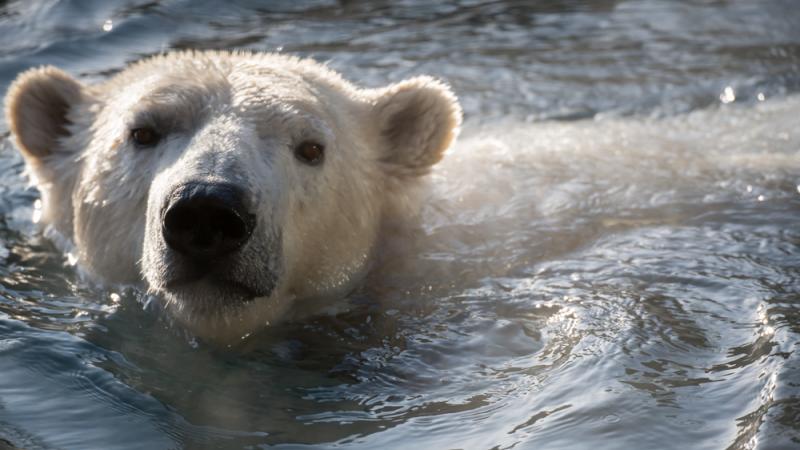As sea ice melts, wild polar bears are losing weight on land

Zoo-tested tech helps scientists studying bears’ survival strategies in a changing Arctic
A rapidly warming Arctic is taking a toll on polar bears, according to a new study using technology beta-tested at the Oregon Zoo. The study — published this week in the science journal Nature Communications — set out to learn how wild bears are coping as the sea ice they depend on disappears for longer portions of the year.
Though classified as marine mammals, polar bears are increasingly using land in the fall and summer seasons due to declines in the sea ice, which serves as their hunting platform for ringed and bearded seals, their primary prey.
“Wild polar bears live and hunt seals on Arctic sea ice,” said Dr. Karyn Rode, a research wildlife biologist with the U.S. Geological Survey. “But as the ice melts in many parts of the Arctic, they have to spend more time on land, away from their main food source.”
To learn whether the bears might be able to adapt to these changing conditions, Rode and her colleagues deployed collars equipped with video cameras — and sensors tested at the Oregon Zoo — to track 20 bears summering on land over a three-week period.
“The bears we observed employed different survival strategies,” Rode said. “A few rested to save energy, but most remained active. Instead of seals, they ate berries, grasses and bird carcasses.”
Two bears made long swims in open water and found marine mammal carcasses, but they were unable to feed while swimming, she said. Though polar bears are capable of swimming long distances, previous zoo-assisted studies indicate they use more energy traveling by water.
After three weeks of monitoring, Rode says, the findings were not encouraging.
“All but one of the bears lost weight over the observation period,” Rode said, “This indicates that polar bears cannot adapt to spending increasing periods on land. More time spent on land results in more weight loss, depleting critical energy reserves needed to support reproduction and survival.”
It’s not good news, but conservationists say the data will be helpful for those working to save polar bears in the Arctic.
“The findings help us understand how polar bears survive in the wild,” said Amy Cutting, vice president of conservation for Polar Bears International. “As sea ice retreats, scientists and wildlife managers need to know how polar bears are responding.”
This isn’t the first time Oregon Zoo bears have lent a helping paw to conservation science. In 2012, polar bears Conrad and Tasul became the first of their species to allow voluntary blood draws. The breakthrough was huge in terms of advancing animal well-being and veterinary care, and it also opened the door to other possibilities. Polar bears are extremely difficult to observe in the wild, and the zoo’s training advances presented a unique opportunity to fill critical knowledge gaps.
After reading a news story about this milestone, Rode reached out to the zoo for assistance with her Arctic research. Zoo bears helped Rode and her colleague Anthony Pagano learn how climate change is affecting the diets of wild polar bears, calibrate tracking collars, and understand the caloric requirements of wild polar bears on land and at sea.
“Zoo bears are perfect candidates to help,” Cutting said. “They already participate in many healthcare behaviors voluntarily, and that has led to some breakthrough studies.”
All these collaborative efforts couldn’t come at a more urgent time. Polar bears are classified as threatened under the U.S. Endangered Species Act, and the International Union for the Conservation of Nature’s Species Survival Commission has designated the species as facing a high risk of global extinction.
More News

Rescued cougar cubs are venturing out
A pair of orphaned cougar cubs, rescued and brought to the zoo by Washington Department of Fish and Wildlife staff in November, have begun exploring their outdoor habitat.April 17, 2025

Zoo seeks pika watchers for summer season
The Oregon Zoo is recruiting volunteers for Cascades Pika Watch.April 15, 2025

Zoo convenes action for imperiled elephants
Sabah government representatives joined conservation NGOs, local communities, palm oil producers, and tourism operators this week in the fight to save the world’s smallest elephants from extinction.April 11, 2025

